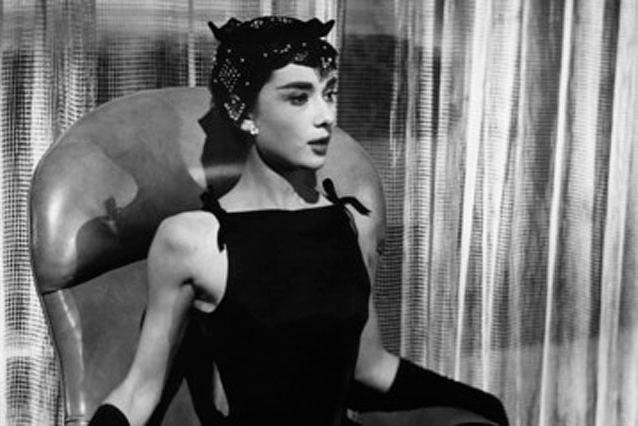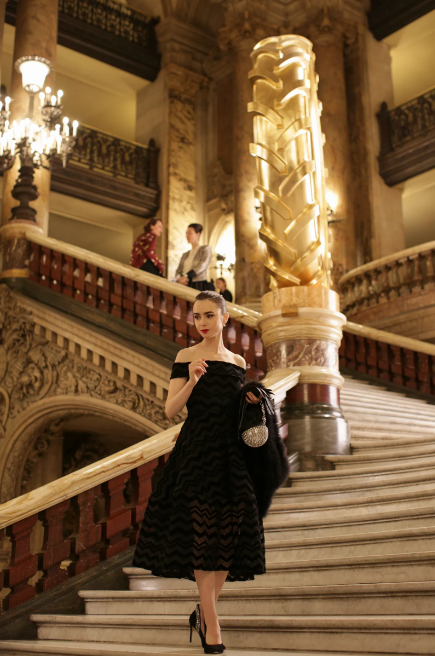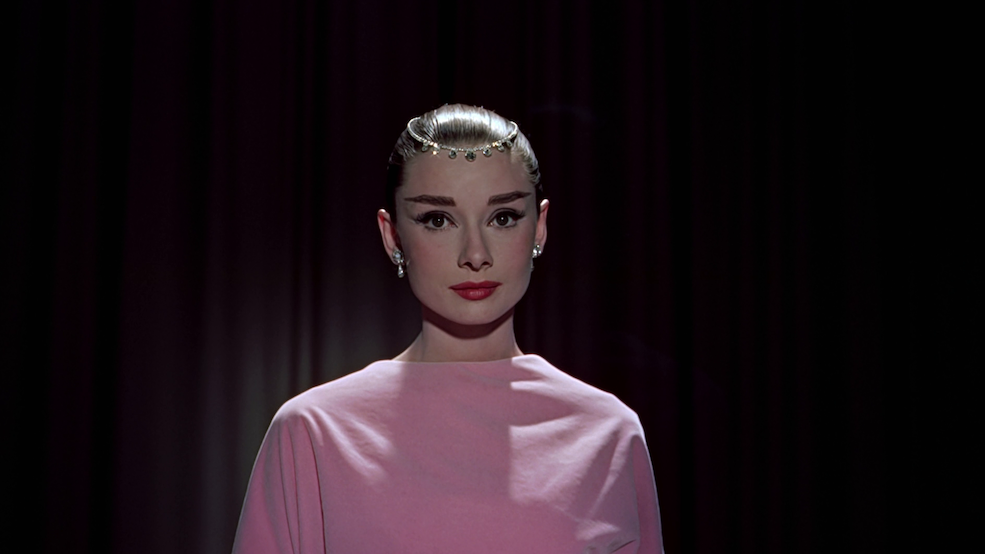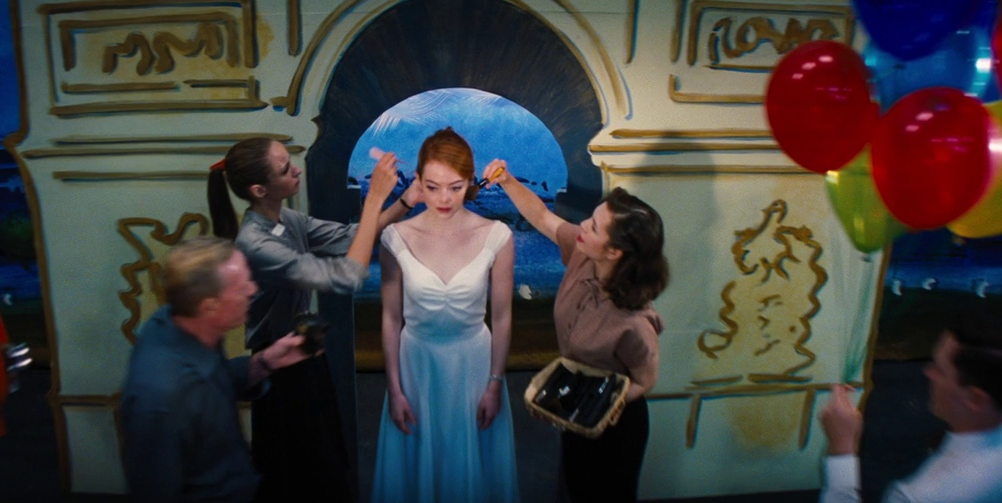How Audrey Hepburn in Givenchy Inspired Screen Costumes Decades Later
Hollywood icons Audrey Hepburn and fashion designer Givenchy became household names individually, but as a duo they made a permanent imprint on film fashion. In an interview with fashion historian Henry Wilkinson, I aim to get to the bottom of their entwined success.
A spinning office chair, a smiling Audrey Hepburn and an outfit that would go down in history - that’s how the world met the first of many iconic looks forged by the collaboration between French designer Hubert de Givenchy and his actress muse Audrey Hepburn. The 1954 classic Sabrina directed by Billy Wilder and starring a still relatively unknown Hepburn was the first of many films the designer and actress duo collaborated on. As the chair stops spinning the camera zooms out to reveal a little black dress in an hourglass silhouette. The dress features a sculpted boat neckline combined with deeply carved armholes, which is now known as the “Sabrina” neckline.
The movie and especially the costuming in it were a success, it was awarded 6 Oscars at the Academy Awards, one of them being Best Costume Design. But not just the critics loved the “Sabrina” look, the people of the time were infatuated with the actress in the french designs and a “Do you look like Sabrina?” contest was launched. Through their collaboration, the pair reached stardom not only in the United States but also across Europe.
Audrey Hepburn in Sabrina (paramount)
The “Sabrina” neckline is not the only reference to Hepburn’s and Givenchy’s fashionable partnership that has reached the 21st century. Outfits from all her past movies, especially the fashion-forward 1957 movie Funny Face directed by Stanley Donen and the infamous 1961 Breakfast at Tiffany’s classic directed by Blake Edwards, have influenced costuming both on the small as well as the big screen. From Netflix’s Emily in Paris to CW’s drama series Gossip Girl to award-winning LaLaLand, the references to Hepburn in Givenchy looks in contemporary screen costuming are abundant. Something draws people again and again to the chic and elegant yet simplistic style that the celebrated pair created during the 50s and 60s. To get to the bottom of how the designs have survived the test of time and why they still influence costumes for the screen, I talked to fashion historian and Givenchy expert Henry Wilkinson.
When I asked Henry about the Hepburn inspired looks in Netflix’s Emily in Paris, whose tacky fashion has been a hot topic online, the last thing I expected was to find out that Lily Collins (the actress playing Emily) had something in common with my mom. Both happen to be Audrey Hepburn fanatics that love to recreate Audrey-inspired photoshoots. “From what I have read and what I've seen, she is a big fan of Audrey Hepburn. She did a photoshoot that everyone was saying was very Audrey style, this photo of her on a bike with a flared skirt and a scarf around her neck,” explains Henry.
I remember the framed picture of my mom in big round sunglasses and a chic black cocktail dress, channelling the classic Hollywood starlet in her own right. Audrey Hepburn has been a presence in my life since I can remember, from her face on paintings, mugs, and even a clock around my childhood home to my mom begging me to watch Breakfast at Tiffany’s with her on lazy Sundays. Hepburn has become an icon admired by many, not just my mom and Hollywood sweetheart Lily Collins.
Her photo taken on the set of Breakfast at Tiffany’s (her hair in an up-do accessorised with a tiara-wearing a pearl necklace and brandishing an old school elongated cigarette holder) has become equivalent to Marylin Monroe’s Warhol portrait in terms of icon status and use of decoration in the most basic of interior designs.
Lily Collins’ pays tribute to the Hollywood starlet in episode six of the first season, as her character, Emily, finds herself at the pompous Palais Garnier located in the 9th arrondissement of the French capital. In the scene she wears a black hourglass-shaped dress with a pearl-embellished headpiece copying looks Hepburn wore in Funny Face. Emily, almost looking overdressed, carries the same elegance as her inspiration gracefully walking up the stairs of the impressive 19th opera house. But the outfit is not the only hint at the 1957 movie, coincidentally part of it was filmed in the same location.
Image: Carole Bethuel/Netflix
However, Henry tells me that the location and Collins’ personal admiration for the Audrey style are not the only reasons for its appearance in Emily in Paris. From a story perspective, the Hepburn references work quite well for the popular TV show's plot. “She is an American, going to Paris and trying to live that potential fantasy of what it is to be this very chic person in Paris. It's an American Parisien crossover. Audrey is a very good touchstone for that because although she wasn't American, she was European. She was starring in Hollywood films wearing French couture. And so there was this definite crossover there,” he explains but elaborates that not only was Hepburn a useful allusion to an American in Europe storyline but Givenchy, popular in the United States with his French designs, provided a direct counterpart to this.
In Funny Face, Hepburn plays a shy bookstore worker turned model who discovers the fashion world of Paris as a young American woman. In a way this is very similar to how Emily in Paris plays out; although not shy, Emily is portrayed as this young American woman navigating through her new Parisian life filled with fashion, luxury, and a new culture to get used to.
Audrey Hepburn in Funny Face (paramount)
Funny Face seems to be a popular choice of Audrey Hepburn movies to use as inspiration; award-winning LaLaLand directed by Damien Chazelle also uses the fashion film classic. Hidden in the epilogue, LaLaLand has snuck in an Audrey Hepburn inspired and memorable Funny Face scenery. The scene shows Emma Stone’s character Mia wearing a romantic white dress while holding balloons in front of a painting of the Arc de Triomphe, a famous Parisian landmark. While the dress she wears bears resemblance to the white embroidered dress with matching gloves that Hepburn wore in Sabrina, the imagery that is painted behind her is influenced by a scene from Funny Face.
In that scene Hepburn’s character stands between the busy Parisian streets and the muddy ground around the Arc de Triomphe, she looks slightly lost during one of her first photoshoots and is handed a bunch of balloons, overwhelming the young model. Although blossoming in her new career the character has to get used to her new Parisian model life. In LaLaLand, Mia moves to Paris to finally find success as an actress, again Hepburn’s look is used to symbolise the American in Paris experience.
La La Land (2016)
Although only a very short scene in a fast-paced epilogue, the 2016 musical makes this symbolism clear through visual elements such as the balloons, the dress and the backdrop. Understanding the Funny Face reference immediately lets us know what the character experiences in Paris within seconds and without any dialogue.
Indeed, Funny Face seems to be a favourite when it comes to referencing classical film costumes in contemporary cinema. But it seems that in pop culture Breakfast at Tiffany’s is more remembered and celebrated, so why all the references to the 'less popular' Funny Face? “I think in the realm of fashion, as well as in film, Funny Face is a massive staple within fashion culture. Because in a way, no one had seen fashion on the screen to that extent before”, explains Wilkinson. The movie changed how film and fashion intertwined and set the bar of what film costuming and collaborations between designers and films can achieve. “She's playing a fashion model and she is sort of doing photoshoots and catwalks in all Givenchy designs. And it's visually stunning. It's absolutely incredible. So that's a very important film.”
One production that never shied away from the well-known Breakfast at Tiffany’s references was the CW drama series Gossip Girl. Leighton Meester’s character Blair Waldorf is your typical wealthy popular girl who desperately tries to find her place in her social circle. Overshadowed by frenemy Serena Van der Woodsen in her everyday life as a New York socialite, Blair often escapes to a dream world where she slips into the shoes of her favourite main character, Holly Golightly from Breakfast at Tiffany’s. Blair dresses up as Audrey’s character Holly on Halloween, watches the iconic movie on repeat whenever she feels upset and overall channels the elegant and European-chic aura that Hepburn is famous for.
Gossip Girl (the CW)
In one of the dreams, Blair appears as Holly Golightly in the opening scene of Breakfast at Tiffany’s. Because Blair is a true perfectionist the dream-sequence outfit is identical to that of her idol; she wears the dazzling tiara in her brunette hair up-do, the big round sunglasses, the multi-layered pearl necklace, the black cocktail dress and the matching elbow-length gloves that all gave the Hepburn look the success it knows to this day. Why did Gossip Girl’s costume Eric Daman choose Hepburn and specifically her character Holly Golightly as a style icon and inspiration for Blair?
“That I think in particular is because of the character and the Breakfast at Tiffany's in that. Even though Audrey is wearing French couture in that film and there is that European elegance. She is presented as this very, very chic New Yorker. And I think it's because of that parallel with Blair's character”, says Henry and elaborates: “[Blair] is sort of trying to fulfil that category of this very fashionable, very chic, slightly European, New Yorker. And so there's definitely that parallel that works in that context.” So while Funny Face outfit callbacks represent the “American in Europe” experience, Hepburn’s Breakfast at Tiffany’s character provides a frame for characters to appear as “European” while living in America, maybe specifically New York even.
The Givenchy-designed outfits that Audrey Hepburn wore throughout her Hollywood career made her into an inspiration for screen costuming even decades later. But what not many people know is that the designer-actress duo almost never met. “It was actually a very coincidental meeting. Audrey Hepburn had just finished filming her first-ever starring role in the film Roman Holiday, which had been released in the United States, but not in France. But she was setting up plans for her next film, which was going to be Sabrina. And in that film, her story, her character goes through a bit of a transformation. And for that both her and the director, Billy Wilder thought that it would be best that they use real Parisian clothes,” Henry tells me.
I expect him to tell me that they had thought of Givenchy right away, but alas I am proven wrong: “[Audrey] was hoping to ask Balenciaga to do the clothes for the film, but he was unavailable. And so they were recommended a very new designer, Givenchy, who at that point had only just completed his third ever collection.” This was the first coincidence that paved the way to the unforgettable collaboration we know today, but this is not where the story ends. “Audrey arranged to meet Givenchy. And as Roman Holiday had not yet been released in France, he didn't know who she was, and was expecting Katharine Hepburn, who was a very well established star at the time.” Audrey wanted Balenciaga and Givenchy expected Katharine, but in the end, they found each other, both at the beginning of their (later on very successful) careers. “Audrey just finished her first starring role and Givenchy at the same time was just opening his fashion house,” says Henry of the time the pair first met in July 1953.
Their first collaboration was simple, Givenchy presented Hepburn with his most recent collection and she was able to pick out three pieces to wear on screen. “A suit, a cocktail dress, and an evening dress. And that's where it all started and took off from there,” Henry tells me. Sabrina was merely the foundation of the success the duo would reach throughout their careers. From then onwards the pair worked on almost every production starring Hepburn. “The few exceptions were historical pieces,” explains Henry referring to the 1956 film War and Peace and the 1964’s My Fair Lady. “[Audrey] did ask him if Givenchy would design the clothes for War and Peace. But he couldn't, he didn't have the time to, you know, create historical pieces when he was trying to make fashion collections for contemporary fashion as well. [...] And the same for My Fair Lady,” says Henry. Audrey loved the Givenchy designs so much that she pleaded with director Stanley Dolan on the set for Two For the Road (1967) to wear the French designer in that film too. “But for Two for the Road, she was playing a sort of a more middle-class wife, and [...] the director sort of put his foot down and said that it just wouldn't have been appropriate for the character [to wear Givenchy],” elaborates Henry.
Even in her years as a Hollywood starlet Audrey Hepburn was perceived as a style icon and this has persevered into the modern day. What is it about the Hepburn in Givenchy style that draws people to it and gives it its timelessness? “As cliche as it sounds, it is genuinely down to the simplicity of the clothes and the ease of the clothes that she wore and Givenchy designed,” says Henry. Although some of her outfits feature elements which could be perceived as vintage or outdated, such as long gloves or a certain type of shoe, the simplicity of the design has left admirers to recreate the style throughout the ages into the contemporary. Designer Hubert Givenchy had understood the importance of simplicity in clothing from his inaugural collection. “Something that Givenchy really championed [...] was this concept of separates, which was designing clothes that could be worn interchangeably. So you could design a blouse, which you could wear with trousers, and then with a skirt and then with an evening skirt and it's what we know now as a capsule wardrobe,” explains Henry. According to Henry, the reason for the eternal popularity of the capsule wardrobe style that Givenchy established, lies in the fact that it remains “very relevant and many people still practice it, and, I think more importantly, very accessible to a lot of people.”
Between the simplicity of the Givenchy designs and the meaning of Audrey’s on-screen fashion, the clothes the duo created have influenced fashion and notably film costuming to the present day. With an Audrey Hepburn biopic currently in production, Hepburn in Givenchy looks might influence a new generation of fashion lovers and movie costuming buffs. Henry leaves me with some thoughts on the biographical film: “I think there's already anticipation of what the wardrobe is going to be like. And so I think that will be a big topic of discussion once the film is released. Definitely.”




